
Algae is an informal term for a large and diverse group of photosynthetic eukaryotic organisms. It is a polyphyletic grouping that includes species from multiple distinct clades. Included organisms range from unicellular microalgae, such as Chlorella,Prototheca and the diatoms, to multicellular forms, such as the giant kelp, a large brown alga which may grow up to 50 metres (160 ft) in length. Most are aquatic and autotrophic and lack many of the distinct cell and tissue types, such as stomata, xylem and phloem that are found in land plants. The largest and most complex marine algae are called seaweeds, while the most complex freshwater forms are the Charophyta, a division of green algae which includes, for example, Spirogyra and stoneworts.
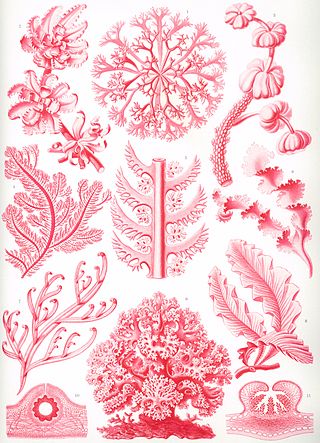
Florideophyceae is a class of red algae. They were once thought to be the only algae to bear pit connections, but these have since been found in the filamentous stage of the Bangiaceae. They were also thought only to exhibit apical growth, but there are genera known to grow by intercalary growth. Most, but not all, genera have three phases to the life cycle.

Atractophora is a monotypic genus of red algae of the family Atractophoraceae. It only contains one known species Atractophora hypnoidesP.L.Crouan & H.M.Crouan, 1848.

The Delesseriaceae is a family of about 100 genera of marine red alga.

Asparagopsis armata is a species of marine red algae, in the family Bonnemaisoniaceae. English name(s) include red harpoon weed. They are multicellular eukaryotic organisms. This species was first described in 1855 by Harvey, an Irish botanist who found the algae on the Western Australian coast. A. armata usually develops on infralittoral rocky bottoms around the seawater surface to around 40m of depth. Marine algae like A. armata are considered “autogenic ecosystem engineers” as they are at the very bottom of the food chain and control resource availability to other organisms in the ecosystem.
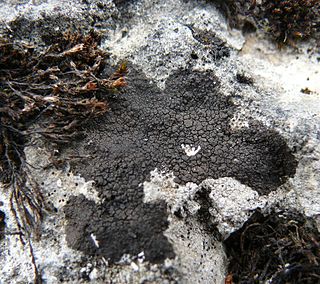
The Verrucariaceae are a family of mostly lichenised fungi in the order Verrucariales. The lichen-forming species, which comprise the vast majority of the family, have a wide variety of thallus forms, and include crustose (crust-like), foliose (bushy), and squamulose (scaly) representatives. Several characteristics of the spore-bearing structures, the ascomata, define the family, including their perithecioid form–more or less spherical or flask-shaped, with a single opening and otherwise completely enclosed by a wall. Squamulose members of the Verrucariaceae with simple ascospores, and without algae in the spore-bearing region are known as catapyrenioid lichens; there are more than 80 of these species. The family has several dozen lichenicolous (lichen-dwelling) examples, including a few genera that contain solely lichenicolous members. An unusually diverse variety of photobiont partners have been recorded, mostly green algae, but also brown algae and yellow-green algae.

Rhodomelaceae is estimated to be the largest red algae family, with about 125 genera and over 700 species.
The Sporolithaceae is the only known family of algae in the Sporolithales order.

Galaxauraceae is a family of red algae (Rhodophyta) in the order Nemaliales.

Nemaliales is an order of red algae.

The Corallinophycidae is a grouping of several calcifying red algal lineages recovered by molecular analysis.
Camille François Sauvageau was a French botanist and phycologist.
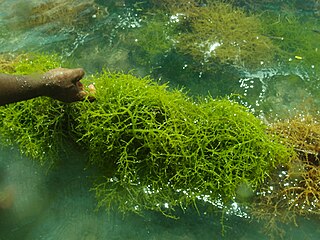
Solieriaceae is a family of red algae in the order Gigartinales.

Bonnemaisoniaceae is a family of red algae in the order Bonnemaisoniales.

Callithamniaceae is a family of red algae (Rhodophyta) in the order Ceramiales. The family was first described by Friedrich Traugott Kützing in 1843.
Balliales is an order of red algae belonging to the class Florideophyceae. The order consists only one family, Balliaceae. with only one genus - BalliaHarvey.

Naccariaceae is a family of red algae in the order Bonnemaisoniales, with 3 monotypic genera. Which are found in both the Pacific and Atlantic Oceans.
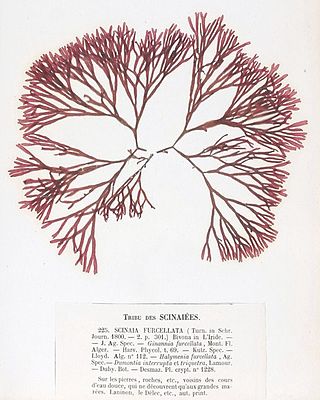
Scinaiaceae is a family of red algae (Rhodophyta) in the order Nemaliales.
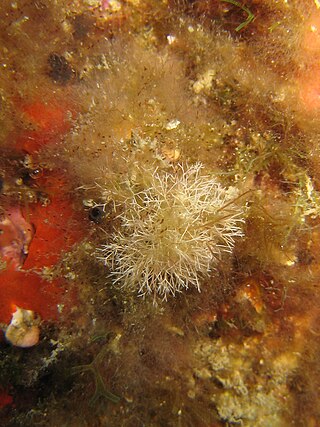
Liagoraceae is a family of red algae (Rhodophyta) in the order Nemaliales. The type genus is LiagoraJ.V.Lamouroux.
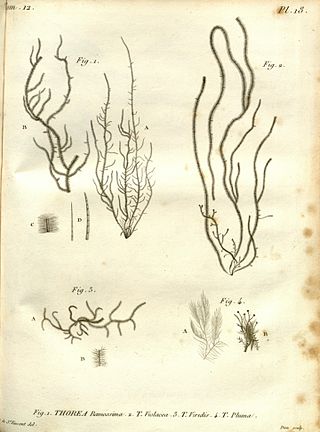
Thoreales is an order of red algae belonging to the class Florideophyceae. The order consists only one family, ThoreaceaeHassall, 1845. The family of Thoreaceae was circumscribed by Arthur Hill Hassall in A history of the British freshwater algae, including descriptions of the Desmideae and Diatomaceae in 1845.
















